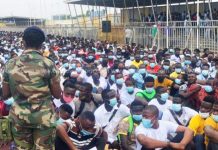Last weekend, I was given the opportunity to explore Kumasi, the ancient capital of the Ashanti kingdom.
It started with an early departure at 6 a.m. As the sun gradually rose, our bus traveled away from the bustling energy and swarming buildings of Accra.
We left behind its urban core and adventured into the city outskirts. As the tall buildings faded away, we became encompassed by a thick wave of trees, as we entered the rainforest region.
Citizens of the surrounding villages lit up as they saw us drive by. They smiled and waved at us. In these villages we saw people engaged in different specialized crafts; such as Goldsmithing, Wood carving, Cloth printing and weaving.
We soon entered the famous Ashanti Region of Ghana, with Kumasi as its capital. Kumasi is the second biggest city in Ghana, after Accra.
We visited Bonwire, a town popular for the weaving of Kente, which is a significant feature of Ghanian culture. The Kente cloth originated in Bonwire and it is told that a group of men in the town invented Kente weaving by admiring the web design of a spider.
Centuries later, the Kente cloth has become widespread throughout the entire Ghana and has also exploded in global popularity.
On arriving at Bonwire Kente Weaving Centre, we headed into a small building that was the center of Kente cloth. Upon entering, one notices the aligned multicolored, diverse Kente, sprawled throughout the wall and the ceilings, and the smiling and welcoming nature of the owners.
One of the shop owners explained the process of weaving the Kente cloth. He said that there is a wooden loom that weaves together threads of dyed fabric. The weaver must sit down, take his shoes off and weave and press. The weaver controls the elasticity through two levers on his feet.
Another significant feature of Kente cloth designs is the Adinkra symbols. These symbols represent concepts and ideas in Ghanaian culture; concepts such as love, God, femininity, knowledge and wisdom. Many of the Kente cloths displayed in the shops expressed these unique symbols.
Following the rich education on the Kente cloth, we headed to a different area of Bonwire to learn about the ink of the Adinkra symbols. This special ink is made out of a Badie tree and goes through a boiling process. The Adrinka stamps are then dipped into the tree liquid and stamped onto the Kente.
Learning about these ancient techniques and processes was humbling. I was inspired by these feats and admired the intricacy and creativity of this specific aspect of Ghanaian culture.
In addition, I was particularly touched by the uplift of these indigenous practices, despite Ghana’s previous threat of colonization.
The Kente cloth, along with the Adinkra symbols, could very well have been taken away by colonizers. Ghanaian’s connection and knowledge of it could have been lost and severed. This is a common pattern for many indigenous populations.
However, the strength of the Kente’s presence in Ghanaian culture is a testament to the unwavering fervor of the Ashanti people. This is an aspect one notices when you step foot in Kumasi.
Accra is a melting pot of different cultures and tribes, but in Kumasi, one notices the palpable air of pride and ancient wisdom from the Ashanti that surrounds the area.
It is this ancient history that reinforces Ghanaian pride and reminds them that they have a rich culture that exists beyond their enforced accounts of slavery and colonization.
The Author – McKenzie Days, U.S. Student Intern at The Chronicle









